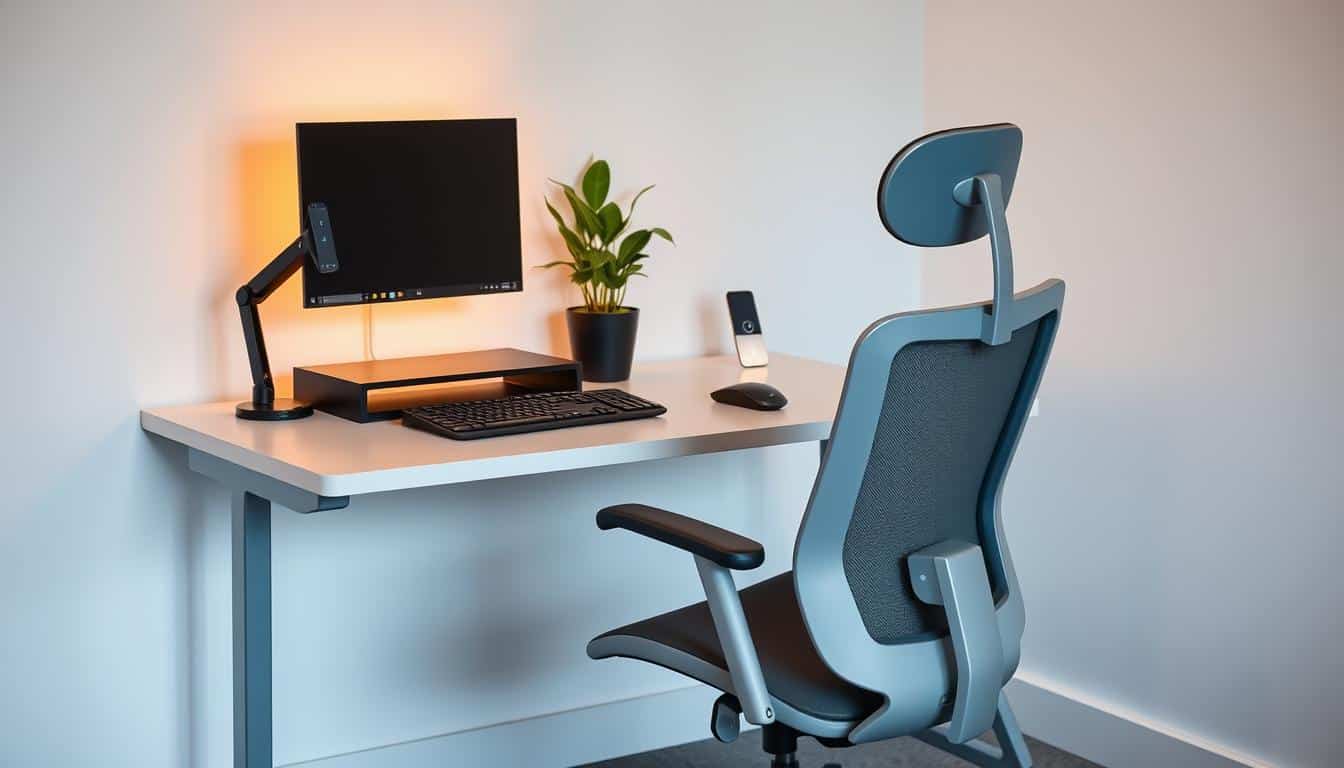In today’s world, productivity and happiness at work are very important. Making a workstation layout that uses space well is critical for getting the most out of your workspace. Good office design boosts productivity and makes employees feel better. Through smart workspace planning, companies can boost teamwork and creativity. This is how they succeed in today’s business world.
The Importance of Space-Efficient Workstation Layout
A space-efficient workstation layout boosts productivity and encourages employee engagement. It uses smart design to streamline workflows and cut distractions. This helps employees concentrate on their tasks. The role of maximizing workspace use is becoming more vital as workplaces evolve.
Enhancing Productivity through Strategic Design
Applying a strategic design to workspaces can hike productivity significantly. A well-thought-out layout cuts down on needless movement. This lets employees quickly reach the tools they need. It also makes teamwork smoother and helps in meeting deadlines easily.
Using tech solutions and comfy furniture enhances this design. These additions greatly improve how happy people are at work.
Impact on Employee Satisfaction and Well-Being
The link between workspace design and employee happiness is clear. A good design lifts satisfaction and overall well-being. It takes into account comfort, easy access, and looks.
Organizations that focus on making workspaces better increase loyalty and team spirit. Elevating the work experience boosts employee involvement. This lays a strong base for a dynamic work culture.

Conducting a Space Audit for Maximum Efficiency
A thorough space audit is key for improving your office setup. It helps find areas that aren’t used much and checks how work flows. Making these areas better can lead to more work getting done and a smoother running office.
Identifying Underutilized Areas
Finding parts of the office that aren’t used right is vital. Here’s how to spot these places:
- Look at layout plans and how space is really used.
- Ask employees what they think about their work area.
- Notice spots that people hardly ever go to.
Analyzing Current Workflows and Layouts
To really improve efficiency, study how employees use their space. Understanding current workflows can show where problems might be. Keep these things in mind:
- See if the way the office is set up affects work.
- Find areas where moving around or talking to others is hard.
- Check if workers can easily get to what they need.
Embracing Open Floor Plans for Collaboration
Open floor plans are now a big hit in lots of modern offices. They boost teamwork by making it easy for everyone to collaborate. This type of layout not only sparks creativity but also fosters a sense of belonging. With no walls to separate them, employees talk more and feel more connected.
Benefits of Open Spaces in Modern Offices
Choosing open spaces for office design has several perks:
- Teams work better together because it’s easier to talk to each other.
- It’s a smart way to use space and can cut costs.
- The workspace can change as needed, supporting different ways of working.
Natural Light and Its Role in Productivity
Natural light does wonders for employee output and mood. Thanks to open floor plans, sunlight can fill the space. This has many benefits:
- It boosts energy, making the office more lively.
- It lessens eye strain and headaches from artificial lights.
- It enhances overall well-being, leading to better focus and work performance.
Implementing Flexible Furniture Solutions
Flexible furniture solutions are key to better modern workspaces. By choosing modular desks and adjustable chairs, companies can support different work styles. This makes offices more efficient and ready for changing team needs.
Modular Desks and Adjustable Chairs
Modular desks let offices change layouts to meet their needs. They can adjust for various team sizes and projects. Adjustable chairs help people work comfortably, boosting productivity. These pieces work together to improve any workspace.
Creating Multi-Purpose Workspaces
Designing spaces with many uses helps with teamwork and new ideas. These areas can be for meetings, breaks, or brainstorming, allowing teams to change their activities easily. This setup boosts creativity and teamwork, using space well and increasing work output.
Optimizing Storage and Organization Techniques
Making your workspace free from clutter and efficient is key to boosting productivity. Using great storage strategies really helps. Making use of the space up high means a tidier office. This make things flow better and keeps everything well organized.
Utilizing Vertical Space Effectively
Using the space above can make a big difference in how organized an office is. Putting up shelves on walls and finding ways to not use the floor as much opens up the room. It also makes a workplace more welcoming and items easier to find. Using small filing cabinets helps keep documents in order too.
Encouraging a Paperless Approach
Going paperless cuts down on clutter and makes handling documents easier. Depending on digital files boosts how well an organization runs. Cloud storage and digital files mean less paper needed, which makes work processes smoother. Getting everyone to use digital tools helps the whole organization aim for its goals.
Leverage Technology for Space Efficiency
Using technology in the office makes things run smoother and saves space. By using digital tools and new devices, companies can make the best use of their space. This helps everyone work better and keeps the office from getting too crowded.
Digital Tools to Minimize Physical Storage
Digital tools cut down the need for big file cabinets. With cloud storage, workers can get to their files from anywhere, making it easier to work together. This means no more fighting over desk space. Here are some top digital tools:
- Cloud storage platforms like Google Drive or Dropbox
- Document management software such as Evernote
- Project management tools like Trello or Asana
Integrating Multi-Functional Devices
Devices that do more than one job keep the office neat. Think about printers that can also scan and copy. They save space and hassle. Using these devices means:
- Less stuff to trip over since you need fewer machines
- Saving money on upkeep and materials
- Making work flow better, since one device does it all
Design Principles for a Space-Efficient Workstation Layout
To create a great workstation layout, you need to know some key design principles. These ideas help set up furniture and gear so everything works better. They make the workspace more productive and keep employees happy. Using the shortest distance, the smallest area, and flexible design is crucial for a workspace’s success.
The Principle of Shortest Distance
The principle of shortest distance is super important for a good layout. It means making the distance short between important spots so employees save time. This helps everyone stay focused and boosts productivity. Here’s what you can do:
- Put often-used equipment and supplies close by.
- Make workstations near places where people come together.
- Have paths that allow quick access to important things.
The Principle of Minimum Area
Using space wisely is the goal of the principle of minimum area. It’s about making the most out of every inch while still being functional. Here are some tips:
- Pick furniture that does more than one job.
- Use built-in storage to save space on the floor.
- Choose options that mount on the wall to leave more floor space.
Flexible Design Considerations
Being able to change things up is key in today’s work world. It helps spaces change based on what the team needs. With flexible design, you get:
- Workstations that change for working together or alone.
- Furniture that moves or adjusts as needed.
- Places made for both team work and quiet time.
Prioritizing Employee Health and Ergonomics
Creating a workplace that values employee health and ergonomics is key to boosting productivity and well-being. It helps lessen missed work days and raises job happiness among employees.
Investing in Ergonomic Furniture
Selecting the right ergonomic furniture is vital for a supportive workspace. Ergonomic chairs and desks keep the posture correct and lessen body strain during long work hours. Look for these features:
- Adjustable seat height to fit different body sizes
- Supportive backrests to lessen spine pressure
- Controls that are easy to use for greater comfort
Quality ergonomic furniture increases comfort and helps prevent muscle and bone issues.
Incorporating Biophilic Design Elements
Adding biophilic design to the workplace boosts employee health. This approach uses natural elements like plants, water features, and sunlight for a calming atmosphere. The advantages are:
- Better air quality with indoor plants
- Improved mood and less stress
- More focus and productivity from a nicer work setting
This design supports physical and mental well-being, making a happier, more productive team.
Conclusion
Setting up a workstation that uses space well is key to boosting productivity and teamwork. By using smart design tactics, like checking how space is used and choosing adjustable furniture, businesses can make the best use of their areas. This leads to happier employees.
It’s also important to use technology right and focus on health with ergonomic setups. Doing this not only makes people work better but also keeps the workplace healthy in the long run. As office needs change, it’s vital to include these features in your workspace design.
Putting money into a great workstation layout is more than just following a trend. It’s a powerful move that improves work performance and health. Companies that adopt these ideas are setting themselves up for ongoing success in the competitive business world.



